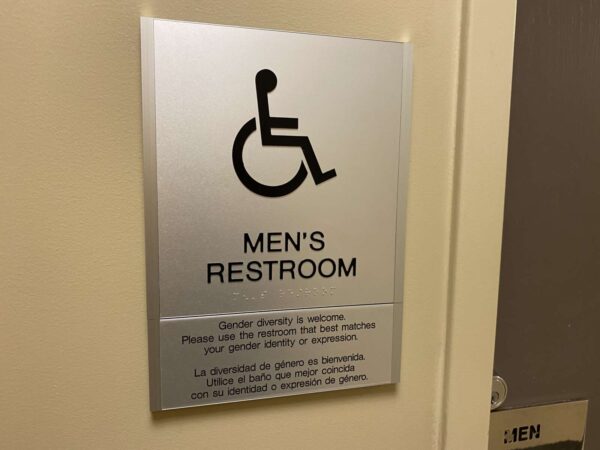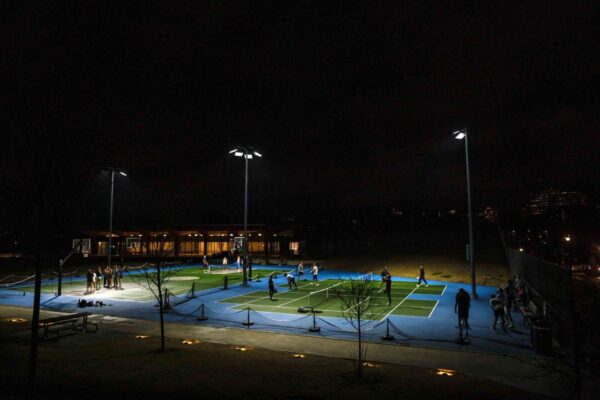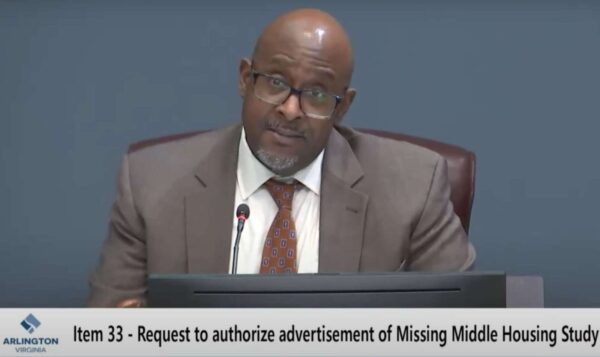
A controversial decision by Arlington Public Schools to change staff bathrooms so they do not lock from the outside has incited backlash from a number of teachers.
APS is embarking on a “lock and key” project to maintain the safety and security of buildings and “improve the key inventory process” at its 42 school buildings, per an email sent from Washington-Liberty High School Principal Antonio Hall to staff, shared with ARLnow.
As part of that work, single-occupancy staff bathrooms would be changed to only lock from the inside, granting access to students and staff who previously could not use these facilities.
Bathrooms within classrooms and clinics would have no locking mechanism at all, and for these facilities, “it is encouraged that signage be created if desired,” per an FAQ document prepared for staff, also shared with ARLnow.
The changes will “ensure all staff including maintenance, bus drivers, etc. have access without access to a key. In addition, this conversion ensures that all students have access to a single use bathroom regardless of the reason,” the document said.
Staff were informed of these changes on Wednesday and told they would be happening over spring break, which starts after school lets out today (Friday), teachers say. APS was not able to return a request for comment before deadline.
Teachers, some of whom shared comments to ARLnow under the condition of anonymity, say they feel disrespected by administrators. They are also frustrated that administrators made the decision without consulting any of the three teacher committees, according to Josh Folb, a leader within the teachers union Arlington Education Association.
The teachers who spoke to ARLnow said a number of staff restrooms have already been converted into single-use restrooms accessible to all students, prompting concerns that this will give students another place to use drugs.
Here is what one high school teacher had to say:
It is dumbfounding that less than two months after the death of a student due to overdose and countless more incidents of drug usage and risk assessments, the school district [is] determined to apply an overwhelming mandate that increases student risk (not safety) without any input, thought of execution, within a minimal timeline, and what would be assumed as an astronomical cost. All of this on top of the fact that it would now wholly remove any location for teachers to access a private restroom consistently during the already limited time that we do have.
My imagination runs wild at this notion considering we find new Instagram accounts every year created by students where pictures of teachers are unknowingly taken and posted on social media. This move would allow students to do so with literally our pants down.
A Washington-Liberty High School teacher with 25 years of experience told the School Board in a letter, shared with ARLnow, that he was “surprised and dismayed” by the decision.
“The currently shared single-use restrooms are already busy, and teachers have limited time for access, mainly between classes,” he said. “This decision represents a major change in my working conditions and environment… As a professional, do I also have reasonable access to a single-use restroom without having to use a group restroom with high school boys?”
During a speech to the School Board last night, Folb said the safe and orderly operation of the schools depends on teachers having a private place to respond to nature’s call and students not having a lockable space to consume drugs.
“Have we learned nothing?” he asked.
(Updated at 11:10 a.m.) Last night, the Arlington County Board took a landmark step to allow the by-right development of 2-6 unit buildings throughout the county.
After the unanimous vote around 6:45 p.m., and additional statements by Board members, the room erupted in cheers from supporters, who shook hands and hugged and high-fived each other. There were, reportedly, a few teary eyes.
A slow trickle of opponents left the room as the meeting wore on, but many remained, swapping their yellow signs against upzoning for blue headstones mourning the burial of the “Arlington Way,” the name for the pathways citizens have for influencing policy-making.
Talk of a policy change like this dates back a decade and, for some Board members, was tied to tearful remembrances of conversations with the late County Board member, Erik Gutshall. After Amazon agreed to come to Arlington, the conversation picked up steam.
Arlington’s first step to increase housing stock was to allow accessory dwelling units. Its second step last night culminated more than two years of study that saw the proposal rebranded and modified to respond to some community concerns such as parking, tree canopy, and the pace of development.
There was lots of celebration on Twitter for the changes, which will go into effect on July 1 of this year.
Thank you @Matt4Arlington @TakisKarantonis @kcristol @libbygarvey @CD4arlington for moving @ArlingtonVA forward! This teacher appreciates this historic moment of righting historical wrongs. #MissingMiddle l pic.twitter.com/XwKErcPNI2
— #TiredTeacher (@pondfamily) March 22, 2023
tonight Arlington passed one of the most progressive zoning reforms in the nation—due in large part to the work of @NAACPArlington, @VOICEVirginia, @TheGattoniCelli and @janefgreen’s YIMBYs of NoVA and many others 👏 https://t.co/ZwWDaukIxk
— dan reed 🦀🏳️🌈👋🏾 (@justupthepike) March 22, 2023
Arlington’s County Board deserves credit for carrying a version of Missing Middle across the finish line.
A ton of that credit should also go to Jane and the NoVA YIMBYs, who organized an entire progressive housing movement from the ground-up. It’s a gargantuan accomplishment. https://t.co/1EvB8RSXpP
— Kevin Saucedo-Broach (@KSBforVA) March 22, 2023
A theme in the speeches County Board members made last night was that change is already here and county leaders have to respond to make sure the real estate market works for more people who want to live in Arlington.
In a statement from the advocacy group Virginians Organized for Interfaith Community Engagement (VOICE), member Pat Findikoglu echoed this sentiment, noting that the county is already changing, with larger, more expensive single-family homes replacing more modest homes.
“Change in the housing market is inevitable,” she said. “How we shape it to meet new needs and still remain livable is the challenge. VOICE believes this Expanded Housing Options proposal does that.”
Board members made a few more compromises, removing a clause that would allow for fewer parking for homes close to certain bus networks, plus approving a five-year cap of 58 units per year and a method of dispersing allowable units by zoning district.
YIMBYs of Northern Virginia co-founder Jane Fiegen Green accepted these limitations on social media but still heralded the decision as a win. She said the limitations could result in “less housing than otherwise.”
“Our organization is concerned that limitations imposed on the policy will yield fewer homes, without any practical or political benefit,” YIMBYs of Northern Virginia said in a statement. “Yet beyond the zoning changes that will help end racial segregation in the County and bring forth more housing, the Missing Middle campaign has shown our neighbors that restrictions on density and growth damage their community’s ability to be welcoming, inclusive and forward-looking.”
One group opposed to the plan did not acknowledge the concessions in its colorful post-mortem.
“This County Board has plopped a half-baked cake on the table that Arlington residents must now eat,” said Arlingtonians for Our Sustainable Future’s Peter Rousselot. “Arlington County is flying blind on Missing Middle, but it’s Arlington residents who now are headed for a crash landing.”
Today, Wednesday, could be the day that the Arlington County Board allows the by-right construction of 2-6 unit homes in the county’s lowest density neighborhoods.
The scheduled vote on proposed zoning amendments, known by the shorthand Missing Middle or Expanded Housing Options, would culminate nearly a year of intense discussion since a draft was published in May and updated in November, and before that, more than a year of study and public engagement.
Ahead of the Board’s vote, more than 250 people signed up to urge the Board to move forward with the most expansive options, build more consensus by making a few tweaks, or reject the proposal altogether. The long list of speakers led the County Board to dedicate its regular meeting Saturday and carryover meeting Tuesday to hearing public comment, pushing the vote to today.
On Saturday, about 200 people spoke during the marathon meeting that went from around 8:30 a.m. to just before 6 p.m.
Of the 204 speakers who took the podium on Saturday, some 57% were in favor of the zoning changes, according to a spokesman for YIMBYs of Northern Virginia, an advocacy group supporting the change. At the conclusion of Tuesday night, 226 people had spoken across the two days of hearings, of whom nearly 54% were in favor.
About 50 speakers in support outnumbered about 20 opponents during Planning Commission hearings earlier this month, per commissioner Daniel Weir.
Representatives from the Planning, Transportation and Housing commissions, as well as the Disability Advisory Commission, all voiced strong support for the proposal. By another metric, more than 6,000 people have signed a petition against the proposal as of Tuesday night.
On Saturday, a number of renters and homeowners shared their personal stories of saving — or trying to save– enough money to buy a home in Arlington to underscore the stakes of the changes.
Proponents said more people would have the option to stay in Arlington with Missing Middle housing allowed throughout the county. Opponents disputed how helpful it would be, with some predicting surging property values should the zoning changes be approved. Other opponents predicted the dwellings would deflate property values and jeopardize their long-term investments.
Through an interpreter, Héctor Herrera urged the Board to allow Missing Middle to give Hispanic residents more home-buying opportunities. He and his wife tried twice, unsuccessfully, to buy in 2010 and then in 2016, while working two jobs and even with the help of their adult children.
“Since I came to the U.S. — and I thank God for this wonderful country — I have worked this whole time in the construction industry in Arlington,” Herrera said. “I’ve seen how much it costs to build a house that costs more than $1 million. My community that represents 20% of Arlington cannot buy a house.”
Update at 9:40 a.m. — The Saturday County Board meeting is underway and 248 people are signed up to speak about Missing Middle. The Board expects to hear speakers today and during its Tuesday meeting before deliberating and potentially voting on Wednesday, according to County Board Chair Christian Dorsey. The Wednesday meeting will start at 4 p.m.
Earlier: The Arlington County Board is set to vote Saturday on zoning changes intended to add housing by allowing greater density in single-family neighborhoods.
The vote is the culmination of nearly a decade of discussion by elected officials that picked up steam after Amazon agreed to come to Arlington.
Since then, the county has taken incremental steps toward increasing housing. First, it allowed accessory dwelling units. Then, in fall 2020, it kicked off the “Missing Middle” housing study.
After more than two years of grassroots advocacy, politicking and vigorous debate — some of it caustic, introspective and divisive — County Board members have a final vote on their weekend agenda. There are no indications, at least as of today, that the discussion will get moved to the Board’s traditional carryover meeting next Tuesday.
The rezoning plan known as Missing Middle has been rebranded and modified in response to some community concerns such as parking, tree canopy, and the pace of development. The county intends it to address the racial, socio-economic and environmental impacts of previous exclusionary housing practices, in addition to allowing more of the moderate density housing currently limited by zoning codes.
Ahead of the vote, a trio of current and former Planning Commissioners, including two architects, published a guidebook with 12 “fixes” they say will help the county meet its goals more effectively. They say the goals of the current proposal are understandable and laudable but they predict numerous problems once the plan is in place.
“We felt that it was important to… not just criticize what the county has, but study what other communities have done and put on the table proposals that address some of what we see as planners and architects as shortfalls in the county plan,” said architect and former commissioner Brian Harner in a meeting of the Arlington County Civic Federation housing committee Thursday night.
The “fixes” range from placing more limitations on height, lot coverage and density to allowing more accessory dwelling units — effectively creating cottage clusters — and building in tools to incentivize affordability and reuse of existing homes, rather than teardowns.
These may come too late, given the vote is set for tomorrow, but Harner chalks this up to the public engagement process once the county had a draft in October 2022.
“The process was teed up in such a way that there was no chance for adequate public discussion,” Harner tells ARLnow.
For instance, the Planning Commission had just over one week to read the document and prepare for three meetings in rapid succession around the Thanksgiving holiday.
“In response, we created the guidebook, hoping to chart a course to a more well-considered EHO,” he continued, using the abbreviation for “Expanded Housing Options,” another term used by the county for Missing Middle. “The Board should pause and improve its proposal before adoption, but if not, we hope our work provides a set of tools to help Arlington get to a better EHO through the follow-on work that will be essential for overall success.”
Specifically, they say the proposal allows buildings that are too tall, too big and too dense, while falling short on affordability, equity, environmental preservation and neighborhood character. The Missing Middle proposal limits multifamily structures on lots to what is currently allowed for single-family detached homes, which the guidebook authors suggested is too big.
“We don’t see it as a zero-sum game where density fights against other qualitative aspects,” Harner said in the CivFed meeting. “We think we can have them both.”

A battle over how to improve public confidence in county government has driven a wedge between two large community organizations in Arlington.
The Arlington branch of the NAACP is leaving the Arlington County Civic Federation after a bitter battle over two resolutions intended to recommit the local government to the “Arlington Way.”
The clash came to a head last night (Wednesday) when delegates to the federation of civic groups voted 75-32 for a resolution, introduced by some former CivFed presidents, that included harsh criticism of county processes.
The NAACP had proposed a milder substitute resolution, focused on improving public engagement.
The tussle is downstream of two shifts in Arlington. The first occurred amid the racial reckoning of 2020, which resulted in CivFed pledging to be more diverse. The second occurred as Missing Middle, the proposal to allow greater density in single-family home neighborhoods, laid bare issues many residents say pervade civic engagement.
“A few years ago, the NAACP joined CivFed in a good faith attempt to assist the organization evolve, transform and grow; however, our organizational mission, vision, and values don’t seem to align well,” NAACP President Mike Hemminger said in an email shared with ARLnow. “We wish the CivFed the very best in the future.”
He said the NAACP has appreciated the chance to engage with members in recent years.
“Our sincere prayer is that your organization will one day accomplish the diversity, equity, inclusion and sense of belonging that so many are craving from leader organizations in the community,” he said.
CivFed President John Ford said he was disappointed to learn of the NAACP’s decision last night, especially after 98% of members voted for its admission to the federation in 2020.
“CivFed and NAACP continue to share many goals, and the many associations and warm, respectful relationships we have built with our NAACP colleagues will endure,” he said in a statement. “We hope they may seek to rejoin us in the future. And I am certain that the two organizations will continue to collaborate in many areas for the benefit of all Arlingtonians.”
While there is one overt reference to Missing Middle, long-standing criticisms of this zoning amendment permeate the text and its 100-plus footnotes, including one resolution.
It urges the County Board to adopt a policy “preventing implementation of plans, policies or projects (new major initiatives or revisions) in the absence of a thorough and data-supported analysis of the potential and cumulative impacts.”
The NAACP instead urged the county to invest “more resources in comprehensive planning and developing a more sophisticated, data-driven toolkit for anticipating, addressing, and communicating likely impacts from County policies.”
The original resolution ruffled feathers of other community groups, too, including YIMBYs of Northern Virginia, a group advocating for more housing that has been vocal in the push for Missing Middle housing in Arlington.
In its own statement, the group said an appendix to CivFed’s motion is a “100-page laundry list of personal attacks, vague accusations of dismissiveness by County staff and Board members, unfounded insinuations of conflicts of interest by Advisory Group appointees, plus multiple direct attacks on YIMBYs of Northern Virginia.”

Ahh pickleball, the hottest thing going with senior citizens, Tom Brady’s retirement sport of choice, and an unlikely candidate for the second-most controversial story of the decade in Arlington.
As ARLnow was first to report last year, many neighbors of Arlington’s recently-established pickleball courts have come to vehemently oppose it, owing to the loud “pop” the ball makes when it hits a paddle. The percussive sound can be heard within nearby houses, at all hours of the day and — in the case of lighted courts — into the night.
It’s so infuriating to some neighbors, that there have been organized efforts against the pickleball courts, including threats of lawsuits, in at least two Arlington neighborhoods.
That culminated last month in a campaign of dueling pro- and anti-pickleball flyers and posters distributed around Penrose and the Walter Reed Community Center, where the county is planning to build a sizable cluster of dedicated pickleball courts.
From ARLnow’s Feb. 13 story:
In a flyer that’s now being disseminated around the neighborhood, opponents are leveling accusations of “bullying of our children by pickleball players,” “public urination on playground and sensory garden,” and causing “excessive continuous noise from dawn to 10 p.m. every day.”
If more pickleball courts are added, it will even be more of a “public nuisance” the flyer says. It does not go into greater detail about the accusations.
“Arlington County is giving away our rights to Walter Reed Community Center (WRCC) to build a dedicated Pickleball Cluster,” it reads. “Current issues will get worse with conversion of 3 tennis to 9 pickleball courts.”
The fracas was noted a few days ago by Axios, which led to a lampooning last night on The Late Show with Stephen Colbert. (See 0:52)
#Meanwhile… Turf battles over space for pickleball courts have erupted nationwide, and England’s new king is opting for a cruelty-free coronation. #Colbert pic.twitter.com/JftwGXyJGV
— The Late Show (@colbertlateshow) March 8, 2023
Arlington is not alone in stirring up a full-blown pickleball controversy.
In the Boston ‘burb of Wellesley, Mass., news crews descended last week as townsfolk near pickleball courts rattled their sabres against the infernal pop, a matter of civic concern for at least a few months. Pitched pickleball opposition over in Cape Cod prompted the hiring of noise-control consultants and a Wall Street Journal article last summer.
Pickleball players, of course, are inclined to defend their sport, which is rocketing in popularity as a recreational activity and attracting the attention of celebrities, pro athletes and large companies. There are hopes that pickleball paddles and balls will evolve and become quieter. But that’s not going to stop people from playing and there’s an argument to be made that the noise isn’t that bad all the way across the street from a court.
For the time being, though, it’s undeniable that outdoor pickleball can be loud and annoying to at least some neighbors. Which side of the proverbial net are you on?
Hat tip to Flood Czar

(Updated at 8 p.m.) Despite protest from some students, faculty and alumni, Marymount University will be removing some majors, mostly in the humanities, from its catalogues.
On Friday, the Board of Trustees voted 20-0 to move forward with the plan, university spokesman Nick Munson said. He asserted that the change was faculty-led and administration-supported and the eliminated majors were “no longer serving Marymount students.”
“The impacted majors are rarely selected by Marymount students and, in fact, have only graduated a handful of students in the past decade,” said spokesman Nick Munson, noting that 74 students have declared majors that will soon be cut. “This decision reflects not only our students’ needs, but our responsibility to prepare them for the fulfilling, in-demand careers of the future.”
Ahead of the unanimous vote, some faculty, students and alumni decried the decision and tried to prevent it. Earlier in this process, a majority of faculty in the faculty council voted in favor of a different proposal that would see two programs cut and course consolidations to others to save some money. Students and alumni sent President Irma Becerra letters and two demonstrations were held.
They are still planning demonstrations, with a third set for tomorrow (Wednesday) afternoon.

Marymount says it is making these changes to improve its finances and cut programs with low enrollment.
Two recent signs of rocky finances include assessments by Forbes and Moody’s Investors Service, according to a joint letter from Marymount alumni.
“In the 2022 Forbes College Financial Grades, Marymount University was bestowed a financial grade of ‘D’ — the lowest grade on Forbes’ scale — with a financial GPA of 1.39,” the letter said.
Moody’s downgraded the university’s issuer and debt ratings to B1 and Ba3, due to a combination of factors, including “very high financial leverage with thin operating results, declining liquidity, debt structure risks inclusive of a project financing currently subsidized by the university, and a highly competitive student market.”
The alumni used these two points to argue that Marymount’s decision will “bring instability to the institution during a time that requires much needed stability.”
But Moody’s downgraded school ratings still seem warm to the programmatic changes the school is making.
“New financial leadership is deliberately focused on realigning student programming, right sizing expenses and enhancing revenue,” Moody’s said.
Marymount provided numbers breaking down how many students are majoring in the fields headed to the chopping block.
- B.A. Art (10)
- B.A. Economics (13)
- B.A. English (15)
- B.A. History (15)
- B.S. Mathematics (6)
- B.A. Philosophy (3)
- B.A. Secondary Education (0, though this was not a primary major)
- B.A. Sociology (8)
- B.A. Theology & Religious Studies (0)
- M.A. English & Humanities (4)
“These programs are simply not ones that are in demand,” Munson said. “However, we will continue to provide a strong liberal arts core and offer classes in the subjects above.”
Students will still be required to study these subject areas as part of the school’s core curriculum, and Marymount will continue offering a more general bachelor’s degree in Liberal Studies.
“Marymount will always be dedicated to the education of the whole person,” Munson said. “Every one of these foundational subjects remain part of our core curriculum, which supports our mission and Catholic identity.”
Alumni say this won’t achieve the same outcome.
“It would… erode — not strengthen — our intellectual community, which must be multidisciplinary to ensure students are prepared for the challenges and opportunities they will face in our present and future world,” the letter said.
Budget materials shared with ARLnow show the school forecast lower tuition revenue this fiscal year from in-person undergraduate and graduate students, but higher revenue for students in online programs.
Last fall, per the presentation slides, Marymount was staring down a budget deficit of $3.5 million.
Those opposed to the cuts argued that the moves would not realize much savings, given that most faculty would have to remain on staff to teach the core curriculum. They instead pushed for the school to focus more on growing its fundraising take.
Tax documents indicate Marymount’s net income in recent years has generally ranged between $1 million to $5 million per year, with losses in some fiscal years (available figures run through mid-2021). In recent years, donations swung between $2.5 million to $5.7 million.

(Updated at 12:20 p.m.) Some 200 speakers and seven hours of public comment later, the Arlington County Board will decide whether to authorize hearings on a proposal to allow “Missing Middle” housing later today (Wednesday).
The request to authorize hearings on the zoning proposal was originally placed on the agenda for the Board’s Saturday meeting. After a marathon hearing on Saturday, public comment on the item carried over into the Board’s Tuesday meeting. Rather than make a decision last night, Arlington County Board Chair Christian Dorsey said members will take an extra day.
“The matter is with the Board but we’re not going to pick this up right away, colleagues, we are actually going to consider all the testimony we heard on this past Saturday and tonight — the nearly 200 registered speakers — and convene again once we are able to properly deliberate tomorrow afternoon at 4:00 p.m.,” Dorsey said at the conclusion of the meeting.
Last night’s meeting had fewer speakers than Saturday’s but featured a contentious exchange between Dorsey and an opponent of the Missing Middle proposal.
Dorsey intervened twice during the meeting, as some people objected to Missing Middle supporter Jane Green standing behind other advocates of the proposal, holding a sign so it would be visible on camera.
“We had 180 people speak on Saturday and we didn’t have any of this. We’re not going to have it with 20, alright?” Dorsey said. “Let the people speak. You can’t dictate where people stand, so let’s just continue, thank you.”
When it was Green’s turn to speak, a man moved to stand behind her and next to Adam Theo, a former County Board candidate and the co-founder of YIMBYs of Northern Virginia, an organization that supports the zoning changes.
“Sit down, please,” Dorsey can be heard saying off-screen. “This is childish, this is childish. I will clear the room. Stop it, everybody. I know tensions are high. I know everybody’s excited but we can all be grown-ups, okay? You can either sit down or you can be removed. It’s your choice.”
A man can be heard saying “No, you grow up,” in response to Dorsey. Later, he adds that the Board should “put this to a referendum and let the county vote.” (The county can hold referenda on bond issuances but a referendum on a county ordinance or policy would require authorization from the state legislature, as Virginia is a Dillon Rule state.)
A total of 17 speakers took the podium last night, including many representing organizations, thus giving them three minutes to speak as opposed to the two minutes allotted individuals speaking on their own behalf Saturday.
First up was Jon Ware, speaking on behalf of Arlingtonians for Our Sustainable Future, which opposes the measure.
Saturday embodied a lot of what frustrates folks about this process. In the week prior, the county put out 150 pages of dense materials with new zoning that goes far beyond the core specifics released only on Halloween. On Saturday, the county cut public speaking times, and talked at the people followed by the people often talking past each other.
He asserted that the people who will be able to afford the 2-3 bedroom Missing Middle housing units will mostly be white, and the county has no process or metrics to “track who gets displaced,” a mechanism that Portland, Oregon, which allows these types of dwellings, does have.
NAACP Arlington branch second vice president Bryan Coleman said the “elephant in the room” is the lack of diversity among Missing Middle opponents, especially those who are talking about gentrification and displacement.
Our residential neighborhoods have already gentrified. The average cost of a detached single-family home last year was $1.2 million. Housing in our residential neighborhoods is getting even more expensive, as 170 homes a year are replaced by McMansions. When we’re talking about displacement, we’re usually talking about lower-income residents being priced out or evicted by landlords. The claim here is different: Upzoning will somehow drive property values so high that some homeowners won’t be able to afford the increased property taxes. Neither part of that claim holds up to scrutiny.
He said it’s implausible a few dozen developments per year will cause property values to spike across the county and those who are burdened by taxes can get relief from the county’s property tax relief program.
Proposed Missing Middle zoning code changes are set to go before the Arlington County Board for a first look on Saturday.
The Board is slated to review a request to advertise public hearings on a proposal to allow the by-right construction of duplexes, three-unit townhouses and multi-family buildings with up to six or eight dwellings on lots of up to one acre in Arlington’s lowest-density zoning districts.
The proposal includes several options for regulating the number of so-called “expanded housing option uses” (EHOs) built per year, their density and size, and parking and tree canopy coverage.
If Board members approve this request to advertise (RTA), the Arlington County Planning Commission and the County Board will have two months to pick a slate of regulatory mechanisms before holding hearings and, potentially, adopting the proposal in March.
Ahead of the request to advertise, Arlington County warned that speaking times may be shortened on account of the intense public interest in the wide-ranging changes.
“If 75 or more speakers sign up to speak on one item, speaking times will be reduced to 2 minutes for all individuals and 3 minutes for all organizations,” the announcement said. “Speakers will be notified if speaking times change.”
The County Board members adopted an ordinance allowing such time reductions last month, after droves of residents came out to speak about Missing Middle in meetings over the last year.
In addition to possibly shortening speaking times, the county will prioritize hearing from different speakers this month and in March.
“When people sign up to speak at the March public hearing, the Clerk’s staff will identify those that did not speak in January and place them first in the speaking order, followed by anyone that spoke did speak at the January hearing,” county spokesman Ryan Hudson said. “Anyone that signs up to speak will have the opportunity to do so.”
Ahead of the meeting, Missing Middle proponent group YIMBYs of Northern Virginia said this RTA has been years in the making. It says development under this plan will be as “distributed [and] gradual,” but that the county has to start somewhere.
“To further improve affordability, Arlington policymakers can revisit regulations such as height limits in the future, but they must start by legalizing up to 8 units per lot with minimal regulatory burdens, which requires maximum flexibility in the RTA,” the group said in a statement to ARLnow.
(YIMBY stands for “Yes In My Backyard,” the pro-building counterpart to the build-elsewhere-if-at-all NIMBYs, who generally reject that label.)
YIMBYs of NoVA highlighted other organizations supporting the proposal, including the Arlington branch of the NAACP, the Sierra Club and Virginians Organized for Interfaith Community Engagement (VOICE).
“Arlington faces a fundamental choice between growth and inclusion or stagnation and spiraling inequality,” the group said. “Continuing the status quo would be an unsustainable future for Arlingtonians, forcing more essential workers into long commutes and driving more young families to relocate, often to exurban sprawl.”
Arlingtonians for Upzoning Transparency (AFUT), which opposes the proposal, claims that the plan as written will:
- Make Arlington less diverse;
- Ignore the thoughtful views of experts and its own advisory groups;
- Are not needed to meet the Metropolitan Washington Area Council of Governments’ (COG) goals for housing in Arlington and lack the necessary analysis and planning to begin an iterative process;
- Leave behind low, moderate, and middle-income households — with a one bedroom unit in an 8-plex requiring a household income at 117% of AMI; and
- Are not integrated with our interconnected priorities for transportation, the environment, and job growth.

Arlington Public Schools appears to be looking for a new internal auditor.
The job posting comes after a national government auditors association told APS that the school system asked John Mickevice, the former internal audit director, to sign a problematic contract, per a letter obtained by ARLnow.
When reached for comment, Mickevice declined to discuss what happened but confirmed he is no longer with APS. The job listing for his former position was posted last Wednesday.
Before his departure, the Association of Local Government Auditors (ALGA) had written to the Arlington School Board, saying Mickevive was asked to sign a contract that conflicts with its own policies as well as best practices. The author — ALGA Advocacy Committee Chair Amanda Noble — confirmed with ARLnow that she sent the letter.
In response to questions about Mickevice’s job status and the letter, a spokesman for APS told ARLnow, “I don’t have any details and I can’t comment on personnel matters.”
According to the ALGA letter, dated as of late August, the contract would have allowed the Superintendent to terminate the Internal Audit Director without cause with 90 days of written notice. It also would have allowed the Superintendent to assign duties to the audit director.
Noble wrote that this conflicts with APS policy as well as with international auditor standards and government auditing standards from the U.S. Comptroller General.
Per APS policy:
The Superintendent shall oversee only day-to-day administrative matters such as authorizing the IA’s leave, travel or minor purchases. The IA shall otherwise be independent of the Superintendent’s supervision. The IA’s annual evaluation shall be conducted by the two School Board members of the Committee.
APS policy and international and national standards alike “protect the independence and objectivity of the internal audit function by placing the internal audit function outside the reporting line of areas subject to audit and preventing management’s interference in the auditor’s performance of work and reporting results,” Noble said.
In other words, such a policy is set up to ensure school officials do not influence the outcome of audits.
Noble says the auditor’s independence would be “greatly strengthened by clarifying district policy regarding appointment and removal of the [Internal Auditor] Director and changing the audit committee composition.”
Currently, the committee that directs the Internal Auditor Director and to which the auditor answers is made of two School Board members as well as the Superintendent and Assistant Superintendent. Half of voting members are management, which Noble says increases the chance of interference in the audit process.
Noble says that is not typical of most committees.
“In a recent internal audit benchmarking report prepared by the Council of Great City Schools, no respondents reported that their audit committee included the Superintendent or any member of management,” she said. “All respondents having an audit committee reported the audit committee composition was board members only, community advisors only, or a mix of board members and community advisors.”
The sending of the letter and Mickevice’s departure occurred less than a year after his scathing review of issues that plagued the Virtual Learning Program, which he said earlier this year was “an indigestible meal that is going to make you sick.”
(Updated 9:55 p.m.) Marymount University is developing plans to build a new sports facility on an embattled parcel of county property near its campus.
Currently, the property at 26th Street N. and Old Dominion Drive, in the Old Dominion neighborhood, is home to a temporary road salt storage “dome” and a parking lot used for mulch distribution. In 2019, despite opposition from some neighbors, the county demolished a roughly 90-year-old water storage tank, repurposed for road salt, which was on the brink of collapse.
The tank saga came a few years after the county proposed and later nixed plans to relocate Fire Station 8 from Langston Blvd to the Old Dominion neighborhood.
Now, Marymount University, which was recently ranked for the first time as a national university and is showing other signs of growth — including higher enrollment rates, new softball and wrestling teams and new academic majors — is trying its hand at redeveloping the site.
The school, which has its main campus across from the county property and an additional presence in Ballston, first put forward a plan for the property two years ago. It proposes to build a sports field, a children’s playground and an enhanced walking trails to Missionhurst Preserve, according to a map on the university’s website.
In addition, it would replace the existing temporary salt dome with a new, solar-powered one, along with a mulch area.
A little less than a year ago, it also put forward a proposal to build new diamond fields where the Washington-Liberty High School baseball diamond in Quincy Park and the softball diamond on school property are. Since then, it has been in talks with W-L, Arlington Public Schools and the Arlington Department of Parks and Recreation.
Marymount has advertised an informational meeting on this proposal, scheduled for Tuesday, Nov. 29.
The university said in a statement to ARLnow that the session acts on a suggestion from Arlington County Manager Mark Schwartz to “build consensus among community members and inform them of our proposed plans to create a generational green space for Arlington at 26th Street N. and Old Dominion Drive that would improve and expand recreational opportunities for the County’s residents.”
It added that the forthcoming meeting also acts on a suggestion from a neighborhood association to meet with the three impacted neighborhood groups together. Marymount says it notified and invited Schwartz and the Arlington County Board to the meeting.
“We have put a great deal of thought and consideration into both projects, but these are proposals,” the university said. “We are discussing them with the neighborhood associations to receive their feedback after repeated attempts were made to communicate with the County about them.”
But Arlington County released a statement this afternoon (Monday) to clarify it has not endorsed the project.
“The County and APS received notice of Marymount’s November 29 Information Session at the same time Marymount informed the general public,” the statement reads. “The County and APS are not associated with or participating in the November 29 Information Session and do not sanction the materials or proposals presented by Marymount University.”
Per the statement, members of the Arlington County Board and the School Board have met with Marymount over the last year, at the university’s request, to hear the proposed concepts.
“At those meetings, County and APS staff asked clarifying questions but no decision was reached,” the county said. “At no time did County or APS staff indicate that these proposed facilities were feasible or acceptable.”

